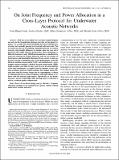| dc.contributor.author | Jornet, Josep Miquel | |
| dc.contributor.author | Stojanovic, Milica | |
| dc.contributor.author | Zorzi, Michele | |
| dc.date.accessioned | 2012-04-26T20:29:17Z | |
| dc.date.available | 2012-04-26T20:29:17Z | |
| dc.date.issued | 2010-10 | |
| dc.date.submitted | 2009-08 | |
| dc.identifier.issn | 0364-9059 | |
| dc.identifier.issn | 1558-1691 | |
| dc.identifier.uri | http://hdl.handle.net/1721.1/70451 | |
| dc.description.abstract | Path loss in an underwater acoustic channel depends not only on the transmission distance, but also on the signal frequency. As a result, the useful bandwidth decreases with distance, a feature not normally present in terrestrial radio networks. This fact motivates the use of multihop communications in an acoustic network, and strongly influences its design, since the same set of protocols will exhibit different performance when operating in a different frequency range. Multihop transmission is considered for large area coverage in acoustic networks, with an eye towards efficient power and bandwidth allocation. Power control is used as a practical means of optimizing the overall performance across the physical, medium access control (MAC) and routing layers. A geographic routing technique, called the focused beam routing (FBR), which requires each node to know only its own location and that of the final destination, is coupled with the distance aware collision avoidance protocol, which regulates the channel access. Results show that the average energy per bit consumption is reduced by adjusting the power, center frequency, and bandwidth in accordance with the network node density. Specifically, as the density increases, greater bandwidths offer per-hop energy reduction as well as a reduced packet collision rate. | en_US |
| dc.description.sponsorship | United States. National Oceanic and Atmospheric Administration (Sea Grant NA060AR4170019) | en_US |
| dc.description.sponsorship | National Science Foundation (U.S.) (grant 0520075) | en_US |
| dc.description.sponsorship | National Science Foundation (U.S.) (grant 0831728) | en_US |
| dc.language.iso | en_US | |
| dc.publisher | Institute of Electrical and Electronics Engineers | en_US |
| dc.relation.isversionof | http://dx.doi.org/10.1109/joe.2010.2080410 | en_US |
| dc.rights | Article is made available in accordance with the publisher's policy and may be subject to US copyright law. Please refer to the publisher's site for terms of use. | en_US |
| dc.source | IEEE | en_US |
| dc.title | On Joint Frequency and Power Allocation in a Cross-Layer Protocol for Underwater Acoustic Networks | en_US |
| dc.type | Article | en_US |
| dc.identifier.citation | Jornet, Josep Miquel, Milica Stojanovic, and Michele Zorzi. “On Joint Frequency and Power Allocation in a Cross-Layer Protocol for Underwater Acoustic Networks.” IEEE Journal of Oceanic Engineering 35.4 (2010): 936–947. Web. | en_US |
| dc.contributor.department | Massachusetts Institute of Technology. Sea Grant College Program | en_US |
| dc.contributor.approver | Stojanovic, Milica | |
| dc.contributor.mitauthor | Stojanovic, Milica | |
| dc.relation.journal | IEEE Journal of Oceanic Engineering | en_US |
| dc.eprint.version | Final published version | en_US |
| dc.type.uri | http://purl.org/eprint/type/JournalArticle | en_US |
| eprint.status | http://purl.org/eprint/status/PeerReviewed | en_US |
| dspace.orderedauthors | Jornet, Josep Miquel; Stojanovic, Milica; Zorzi, Michele | en |
| mit.license | PUBLISHER_POLICY | en_US |
| mit.metadata.status | Complete | |
